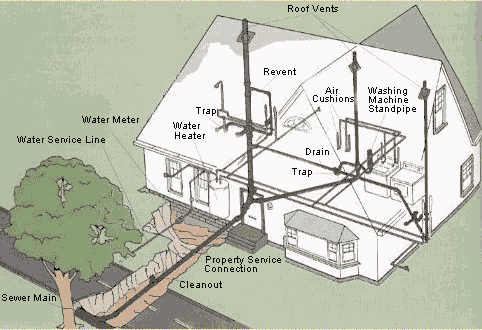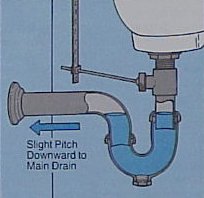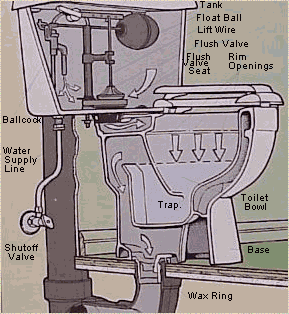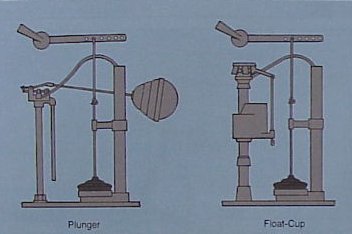Your Home Plumbing System
Being mostly out of sight your home plumbing system tends to remain out of mind until something goes wrong. While it may appear to be a complex maze of pipes, fittings and valves, your home plumbing system is actually rather simple and straightforward. A home plumbing system is made up of three basic components: a water supply system, appliances and fixtures, and a drain system.
Fresh water (potable) enters your home through the the main water supply line connected to a municipal water company or to your well if a municipal water supply is not available. If you are connected to a municipal water supply line your water passes through a meter that registers the volume of water used which determines your monthly or bi-monthly water bill. In many areas your sewer bill is calculated based upon your use of municipal water, with adjustments made for certain months of the year when usage for lawn and garden watering and other outside uses keep a portion of the water from entering the wastewater collection system, thus keeping it from needing to be treated. An average family of four in the United States uses about 400 gallons of water per day.
Upon entering your home the main supply line splits off and a pipe runs to the hot water heater. From the hot water heater, a hot water line parallels the cold water line to supply showers, bath tubs, clothes washers, dishwashers and sinks. Toilets and outside faucets are examples of fixtures that require only cold water. The water supply to fixtures and appliances are controlled with faucets and valves.
Wastewater, any water used within the home that is not consumed, enters the drain system in order to be removed from your home. Wastewater must first flow through a trap, a U-shaped pipe that holds standing water and prevents sewer gases from entering your home. If not used for a lengthy period of time these traps may become dry and sewer odors can enter your home. You need merely to pour water into the drain to refill the trap and eliminate the odor. By state and local plumbing codes, every fixture must have a drain trap.
The drain system within your home works entirely by gravity, allowing wastewater to flow downhill through a series of large diameter pipes. These drain pipes are connected to a vent pipe system that bring fresh air to the drain pipes, preventing suction that would either stop or slow the free flow of wastewater. Vent pipes exit your home through one or more roof vents. You must take care to ensure that these roof vents do not become clogged. Leaves and bird nests are two ways in which these roof vents can become clogged.
All wastewater flows to the main waste and vent stack. The main stack curves to become a sewer line that exits the house near the foundation. In a municipal system this sewer line. known as a Property Service Connection (PSC), or just plain connection, runs to a collector sewer line in the street or in the rear of the home. Where sewer service is not available the line runs to a septic system, which is in essence simple mini-wastewater treatment facility Many Property Service Connections are provided with a ground level Y-cleanout, or two-way cleanout, which allows blockages to be more easily removed. Rather simple in concept, isn't it?
TYPICAL HOME PLUMBING SYSTEM


How a Trap Works
This trap, called a "P" trap due its shape, works to hold or trap water and thereby prevent sewer gases from entering your home. The pipe exiting the trap must be angled slightly downward to facilitate the flow of wastewater into the drain system.
How Your Toilet Works
What is arguably the most important fixture on the home plumbing system? It is the commode, the porcelain throne, the john, and to those who have hugged it or knelt in front of it, the porcelain idol, more commonly called the toilet. In the 21st Century just about every home in the U.S. has one of these fixtures. A large number of families feel a need for more than one. In fact, the number of these fixtures is always a selling point for a home. Homes only have one kitchen or one laundry room, but they can have numerous bathrooms or half-baths (toilet and sink only with no bathing facilities).

When the handle is pushed the lift lever raises a rubber seal called a flapper or tank ball. Water in the tank rushes down through the flush valve opening in the bottom of the tank into the toilet bowl. Wastewater in the bowl is forced through the trap into the main drain. When the toilet tank is empty, the flapper seals the tank and a water supply valve, called a ballcock, refills the toilet tank. The ballcock is controlled by a float ball that rides on the surface of the water. When the tank is full, the float ball automatically shuts off the ballcock.
Typical Types of Ballcock Asemblies
Ballcocks allow water to pass into the tank when the toilet is flushed and shut off the water when the tank fills. Shown here are two popular types of ballcock assemblies. The plunger type has a float arm which applies pressure on a valve and plunger to seal off the incoming water. The simpler, easy to install, float-cup type has no float arm or ball. The plastic cup or fill valve functions to control the water flow.

Plumbing Problem, What Could be the Cause?
Why would your sink, tub, shower or toilet drain very slowly? There are several possibilities, the vent system could be obstructed, there could be a partial obstruction between the individual facility and the main drain, or the main drain could be partially obstructed. If any individual facility does not drain, the problem lies somewhere between the facility and the main drain. If more than one, but not all of the facilites, do not drain properly, then the problem lies somewhere within your home's internal plumbing system. If no facilites drain properly the problem can be either in the main drain within the house or in the property service connection that connects the home to the main sewer line. Obstructions in the property service connection can result from grease build-up, a solid object flushed into the drain line, a caved in line, a swag (dip) in the line that allows solids to settle out and eventually obstruct the line, or roots in the line that have entered at unsealed joints, slipped joints or cracks in the pipe.
In order to avoid these problems to the greatest extent possible you should never flush or dump solid objects, hair, cloth, grease or animal fats into your drain system. You should not plant trees over or near the property service connection. If you experience problems that you cannot take care of yourself you should contact a plumber and/or your local agency that handles wastewater collection and treatment to see what services they provide and what they are responsible for. In some localities the local agency provides no service for the property service connection and the homeowner is responsible for the line all the way to the main sewer line, others provide service for the connection from the main line to the street right-of-way and the homeowner is responsible from the right-of-way line to the home, and in rare cases the local agency is responsible for the connection all the way to the home's foundation.


